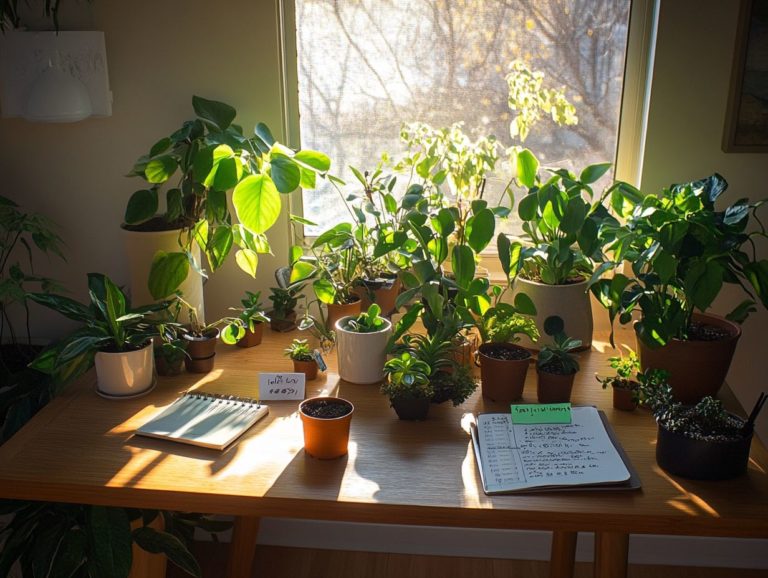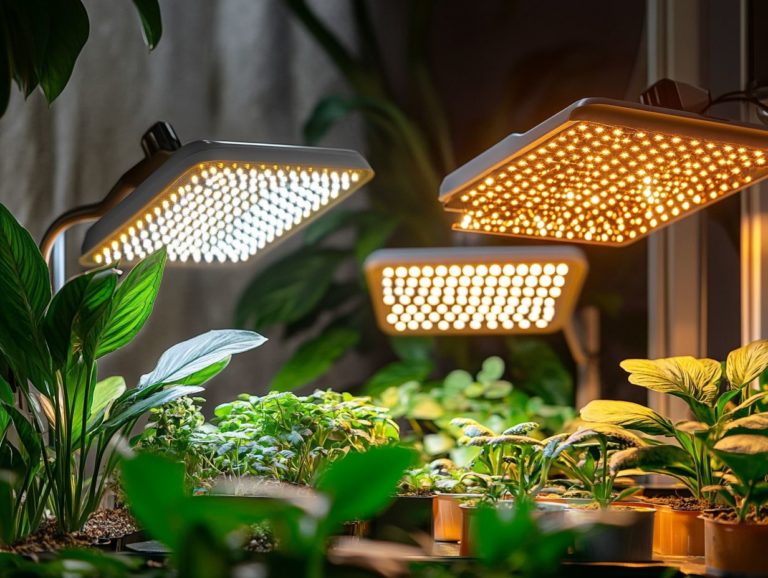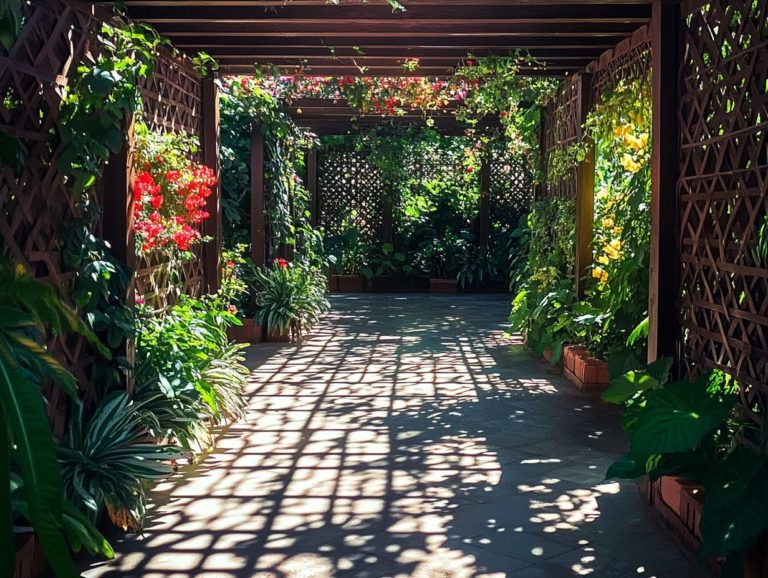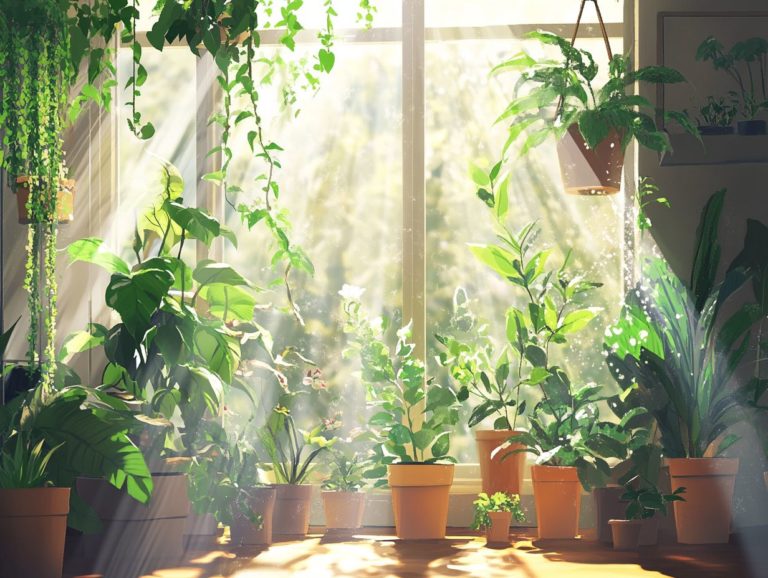Exploring the Benefits of Indoor Plant Lighting
Indoor plants have the remarkable ability to turn any space into a vibrant oasis, but their health and growth hinge on the right lighting conditions.
Grasping the importance of lighting can elevate your indoor gardening experience, resulting in healthier plants, cleaner air, and a reduction in stress levels.
This piece delves into the various types of indoor plant lighting, weighing the benefits of natural versus artificial options while offering essential tips for crafting the perfect environment for your green companions.
Explore how you can create an ideal lighting setup tailored specifically to meet your plants’ needs!
Contents
- Key Takeaways:
- The Benefits of Indoor Plant Lighting
- Types of Indoor Plant Lighting
- Factors to Consider When Choosing Indoor Plant Lighting
- Tips for Setting Up Indoor Plant Lighting
- Frequently Asked Questions
- What are the benefits of using indoor plant lighting?
- What type of plants benefit the most from indoor plant lighting?
- Can indoor plant lighting help improve air quality in a room?
- How does indoor plant lighting affect the growth of plants?
- Are there any additional benefits of using indoor plant lighting?
- Can indoor plant lighting be used in any indoor environment?
Key Takeaways:
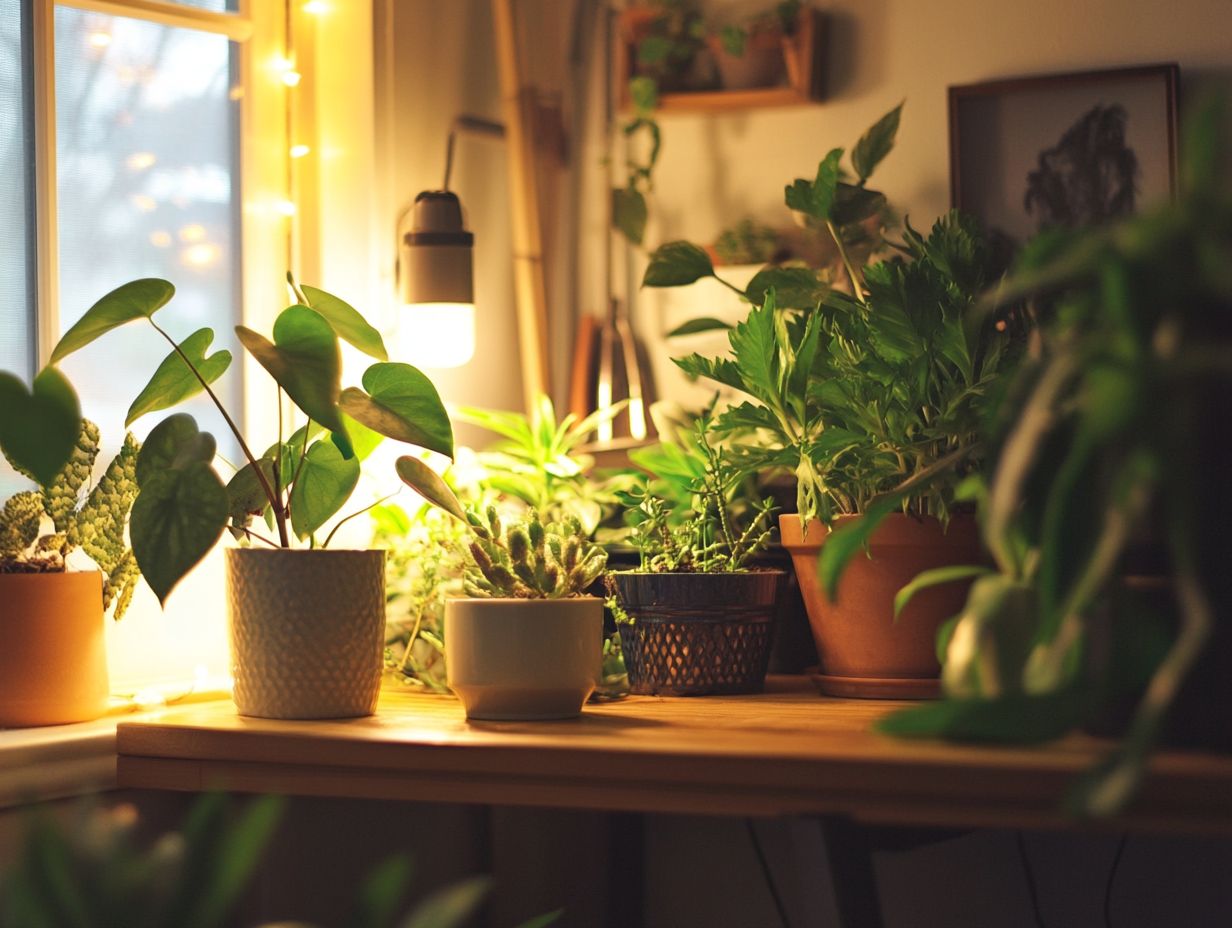
- Indoor plant lighting improves growth patterns and health, purifies air, and reduces stress in plants.
- Natural light is beneficial, but artificial lighting is necessary for consistent plant growth. Different types of artificial lights have varying effects on plants.
- When choosing indoor plant lighting, consider the plant species’ light requirements, intensity, and duration. Proper positioning and adjustment of lights are crucial for optimal plant growth.
Why is Lighting Important for Indoor Plants?
Lighting is essential for your indoor plants, as it profoundly impacts their growth, health, and overall development. Without sufficient light, your plants will struggle to make their own food using light, which hampers their ability to thrive.
Different houseplant species, like African violets, dracaena, and rubber plants, have unique light requirements. These requirements shape how they develop.
Whether you re relying on natural sunlight or supplementing with electric lights, understanding the significance of light intensity, duration, and quality can significantly elevate your indoor gardening success.
Choosing the right light source, such as LED grow lights or fluorescent tubes, will optimize energy efficiency and enhance your plants’ yields.
For instance, full-sun plants like succulents and cacti thrive in bright light and might suffer stunted growth or poor health if they don t get enough of it. In contrast, shade-loving species like pothos and peace lilies flourish in low-light conditions, highlighting the need for customized lighting environments that consider their light requirements.
The light spectrum matters too; it refers to the different colors of light that affect plant growth. Blue light promotes vegetative growth, while red light is crucial for flowering and fruiting. By taking into account energy consumption and the specific light exposure needs of your diverse plant collection, you can curate optimal conditions that foster vibrant, healthy plant life.
The Benefits of Indoor Plant Lighting
Indoor plant lighting offers a wealth of benefits, elevating the aesthetic charm of your living spaces while nurturing the health and growth of your houseplants.
By ensuring adequate lighting conditions whether through natural sunlight or artificial sources you enhance growth patterns and potentially increase crop yields.
The right light exposure purifies the air and creates a tranquil atmosphere, reducing stress in your indoor environment.
Understanding how light quality and duration affect your plants can unlock their full potential and make your indoor garden thrive!
Start transforming your space today with the perfect light setup for your indoor plants!
Improved Growth and Health
The enhanced growth and vitality of your indoor plants are tied to optimal lighting. Light management is essential for every indoor gardening enthusiast.
By providing the right light intensity and duration, you empower your plants to thrive! Using advanced lighting solutions like LED grow lights allows you to control light wavelengths and intensity, catering to the unique needs of various plant species, whether they are vibrant flowering plants or lush ferns.
Different colors of light affect plant health. For example, blue light helps plants grow, while red light encourages flowers. Adjusting these variables can dramatically impact the health and yield of your indoor plants.
For example, a snake plant does well in low light, while herbs like basil crave bright, indirect sunlight to truly flourish. This showcases the diverse light requirements of various plant species.
Creating an ideal growing environment brings your indoor garden to life.
Purifying Air and Reducing Stress
Indoor plants aren t just a feast for the eyes; they play crucial roles in purifying the air and alleviating stress in your living spaces. When paired with effective lighting, houseplants create an environment that enhances both air quality and emotional well-being.
When selecting your indoor greenery, remember that certain species, like peace lilies and snake plants, are particularly good at filtering toxins from the air while thriving in a variety of lighting conditions. Proper light exposure amplifies their air-purifying abilities and impacts their overall health and growth.
Research suggests that these plants can improve mood and focus, making them essential in both home and office settings.
By understanding these dynamics, you can cultivate a harmonious environment that purifies the air while also nurturing your psychological health through appropriate lighting conditions.
Types of Indoor Plant Lighting
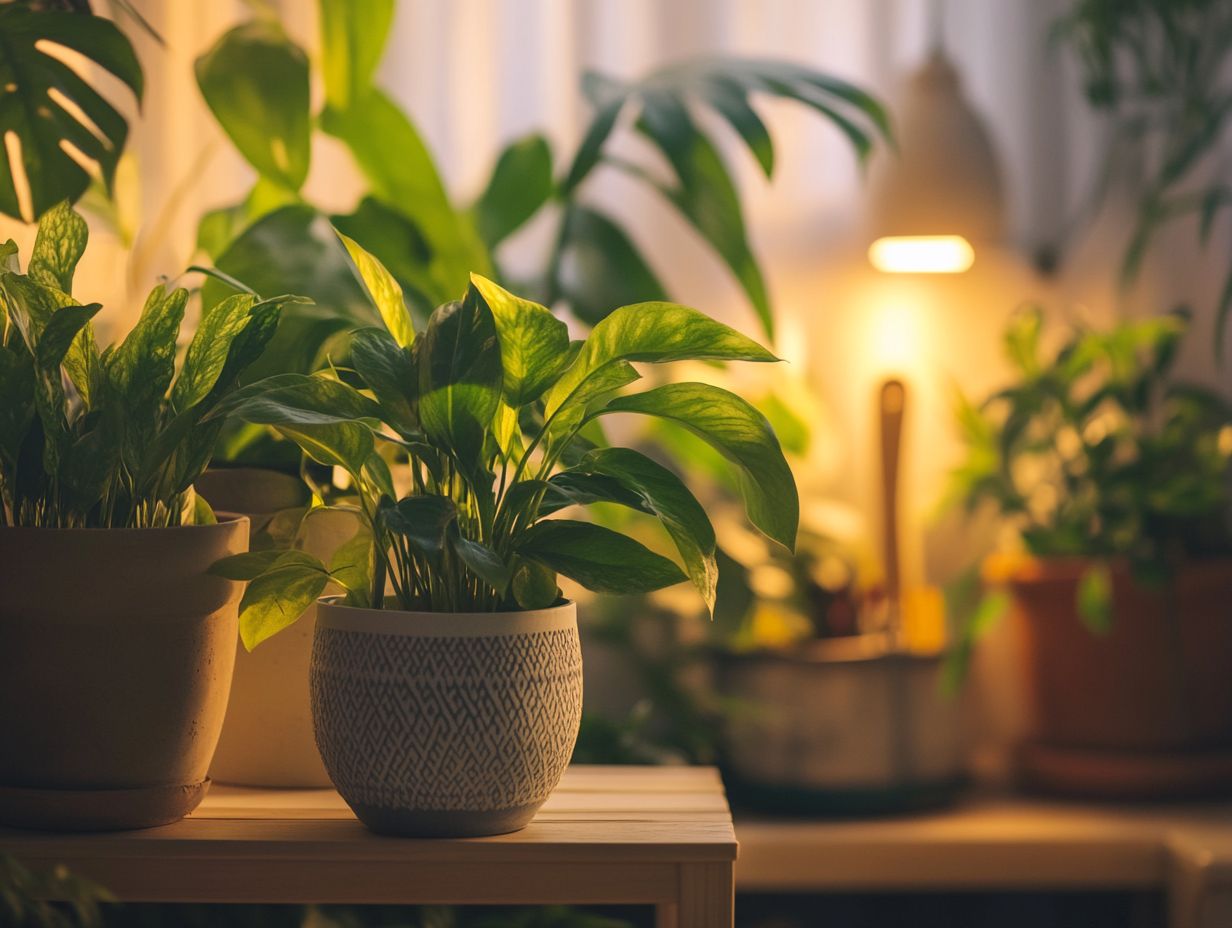
Knowing the types of indoor plant lighting helps your plants thrive, whether you re relying on natural sunlight or various forms of artificial light.
Natural light often reigns supreme in nurturing your plants, but it can be effectively supplemented by artificial sources like LED grow lights and fluorescent tubes to guarantee optimal light exposure, particularly in low-light and medium-light conditions.
Each type of lighting has its spectrum and output, directly influencing how well your plants be it African violets or tomatoes flourish indoors.
Natural Light vs Artificial Light
Natural light, that glorious gift from the sun, is often regarded as the best choice for nurturing indoor plants. However, artificial light can play a crucial role as a vital supplement or even a primary light source in certain indoor environments.
While natural light fluctuates with the seasons and the hours of the day, artificial options like LED grow lights create a controlled setting that can mimic ideal conditions for specific plant species. By understanding the distinctions between these two types of lighting, you can optimize your plants growth and health.
For instance, many popular houseplants, such as peace lilies and pothos, flourish in bright indirect sunlight, making natural light a fantastic choice for these species. In spaces where sunlight is scarce, using the right spectrum of artificial light can enhance photosynthesis and foster robust foliage development.
Conversely, relying solely on artificial sources may present challenges, such as inadequate light intensity or improper wavelengths, which could impede growth.
As a plant enthusiast, it’s essential to experiment with timers and light placement to maximize exposure to your plants’ preferred lighting conditions, regardless of the source. For more insights on this topic, check out understanding indoor plant light needs. This approach ensures your indoor greenery remains vibrant and thriving.
Different Types of Artificial Lights
You have a wealth of artificial lighting options at your disposal for indoor plant care. Each option is designed with unique characteristics to meet diverse plant needs and environments.
While LED grow lights are a popular choice due to their energy efficiency and customizable light spectrum, you will find other lighting alternatives that serve specific requirements and situations. For instance, fluorescent tubes are ideal for nurturing low-light species like ferns and herbs. They offer gentle light that promotes healthy growth.
Conversely, if you are managing a larger setup, high-intensity discharge lights will provide the bright illumination necessary to cover expansive areas.
Grow lights differ in their ability to emit various wavelengths, which can significantly influence photosynthesis rates across different plant varieties. Familiarizing yourself with these options can help you optimize your setup. This way, you can cultivate a thriving indoor garden tailored to each plant’s unique demands.
Factors to Consider When Choosing Indoor Plant Lighting
Selecting the ideal indoor plant lighting requires careful consideration of several key factors that can greatly affect plant health and growth. Understanding these factors is key for every indoor gardener!
The specific light requirements vary across plant species, such as cacti and flowering plants. These differences dictate the necessary light intensity, duration, and light patterns for their optimal development.
By understanding the specific light needs, you can cultivate an environment that meets the specific needs of your indoor plants, ensuring they thrive beautifully.
Plant Species and Light Requirements
Different plant species come with their own unique light requirements, and it is essential to consider these to ensure your indoor garden flourishes. For example, low-light plants like ferns thrive in dim conditions, while high-light plants such as tomatoes demand intense light exposure for robust growth.
Understanding these light needs is pivotal to your horticulture success and can significantly influence your plants development outcomes.
Most indoor plants can be categorized by their light needs: low, medium, and high.
- Low-light plants, such as pothos and snake plants, adapt beautifully to shadier spots, making them perfect for offices or rooms that see little natural light.
- On the flip side, medium-light varieties like peace lilies thrive with some indirect sunlight, requiring a touch more brightness to keep their foliage lush and vibrant.
High-light plants, like succulents and various citrus types, will truly shine in bright, direct sunlight, which is crucial for their photosynthesis. The secret to a flourishing indoor garden lies in matching each species to its ideal light environment.
Light Intensity and Duration
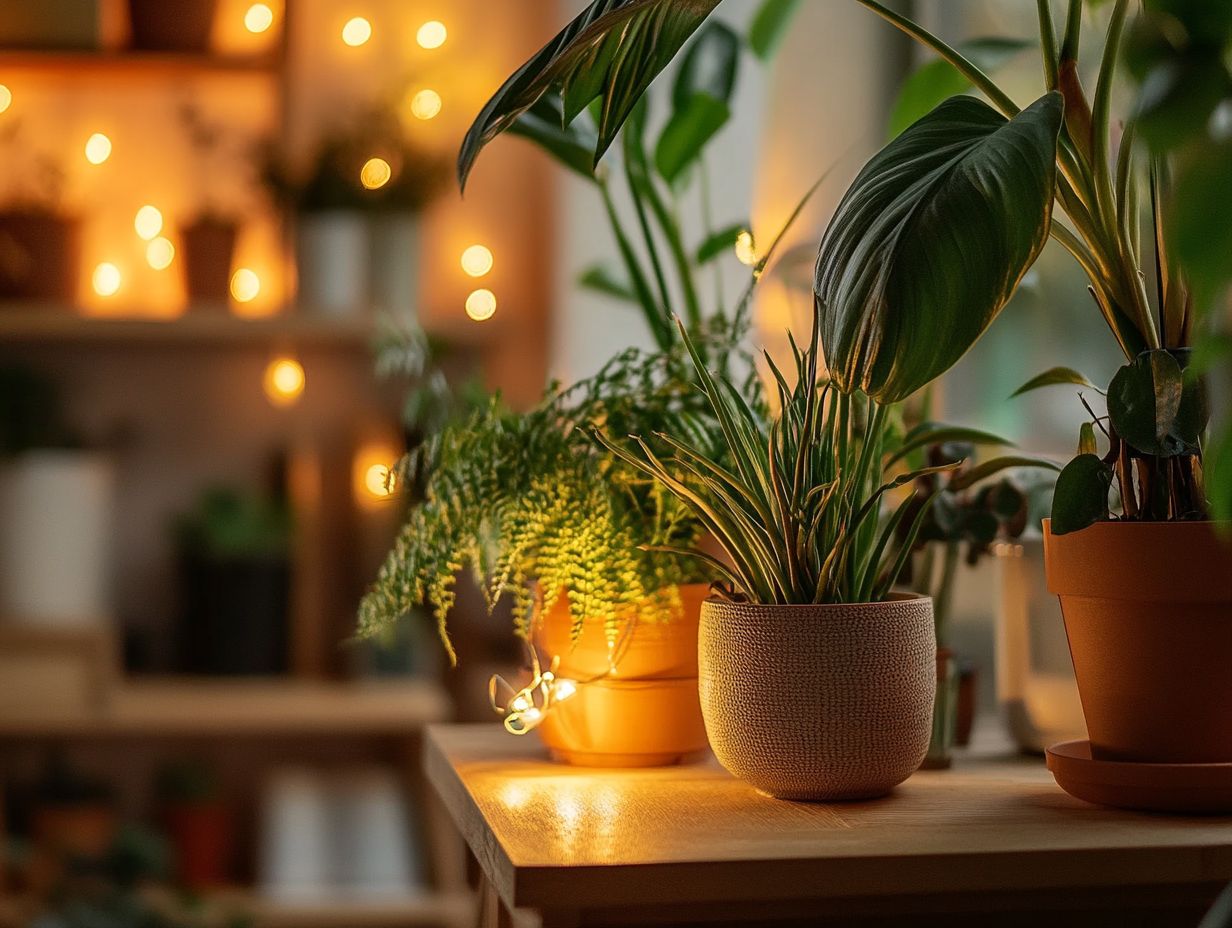
Light intensity and duration are vital for vibrant growth! Get these right to watch your indoor plants thrive!
It is important for you to understand how much light exposure each plant receives daily. Too little light can stunt their growth, while too much can lead to leaf burn or other complications. By optimizing both light intensity and duration, you can enhance energy efficiency and improve the overall health of your plants.
To measure these factors effectively, consider using a light meter to get accurate readings of light intensity in foot-candles (a unit measuring light intensity) or lux. Strive for a light duration of about 12 to 16 hours for most indoor plants, but remember that some species may thrive with either less or more exposure.
For example, succulents typically prefer higher intensity light and longer durations, whereas ferns often flourish under softer, indirect lighting for shorter periods.
Adjusting the distance of your light source and incorporating reflective materials can help you achieve the perfect settings, ensuring that each plant receives just the right amount of energy for optimal growth.
Tips for Setting Up Indoor Plant Lighting
Setting up effective indoor plant lighting needs your careful attention to several key factors. These include positioning, adjusting light sources, and using reflective surfaces to optimize light exposure.
When you position your lights correctly, you can enhance plant growth. This ensures an even distribution of light across your greenery.
Using light timers helps you maintain a consistent lighting schedule. This consistency is crucial for fostering healthy plant development.
Positioning and Adjusting Lights
The positioning and adjustment of lights are crucial for creating a vibrant indoor garden. Placing lights at the right height and angle ensures that plants receive the optimal light exposure.
As plants grow, their light requirements change. You’ll need to make adjustments to maintain that ideal setup.
For small, shade-loving plants like ferns, they thrive under softer, diffused lighting. You can achieve this by placing lights further away or using reflective surfaces to evenly distribute the glow.
Larger, sun-loving plants, like succulents, need closer light sources to mimic their natural sunlight conditions. Incorporating timers can help simulate natural day/night cycles, which promotes healthy growth patterns.
A successful setup often blends LED and fluorescent lights to create the perfect balance of warmth and intensity. This thoughtful arrangement cultivates a beautiful indoor oasis.
Frequently Asked Questions
What are the benefits of using indoor plant lighting?
Indoor plant lighting provides a consistent and controlled light source. This helps plants thrive even in spaces with limited natural light.
What type of plants benefit the most from indoor plant lighting?
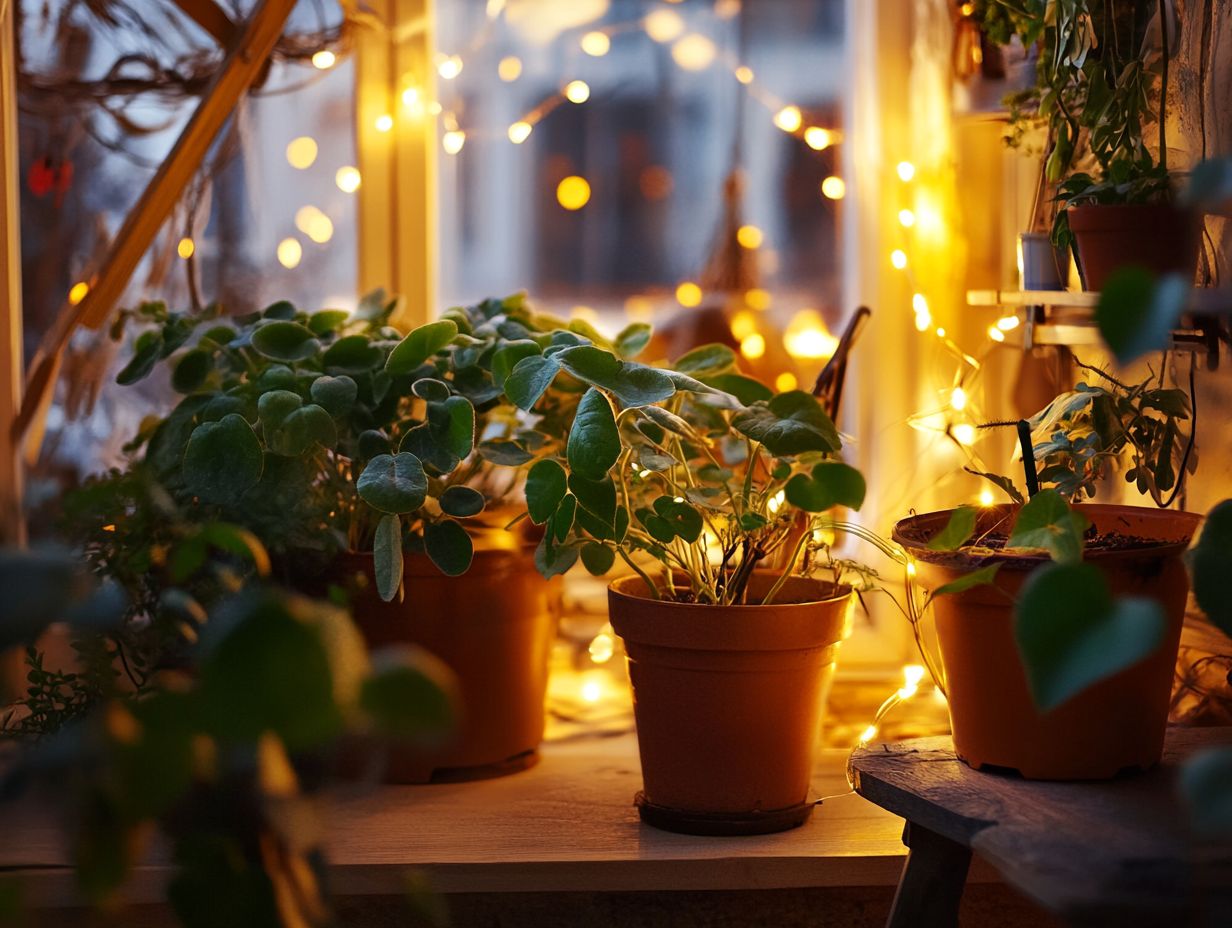
Indoor plant lighting is beneficial for various plants, especially tropical and flowering ones that need more light than what is usually available indoors.
Can indoor plant lighting help improve air quality in a room?
Yes, indoor plants help improve air quality by removing toxins and producing oxygen. Indoor plant lighting supports these plants to thrive and continue purifying the air.
How does indoor plant lighting affect the growth of plants?
Indoor plant lighting mimics natural sunlight, providing the necessary light spectrum for photosynthesis. This promotes healthy growth and development.
Are there any additional benefits of using indoor plant lighting?
Indoor plant lighting not only boosts plant growth but also enhances a room’s aesthetic appeal. It contributes to a relaxing and natural atmosphere.
Can indoor plant lighting be used in any indoor environment?
Yes, indoor plant lighting works well in various indoor settings, including homes, offices, and commercial spaces like restaurants and hotels.

